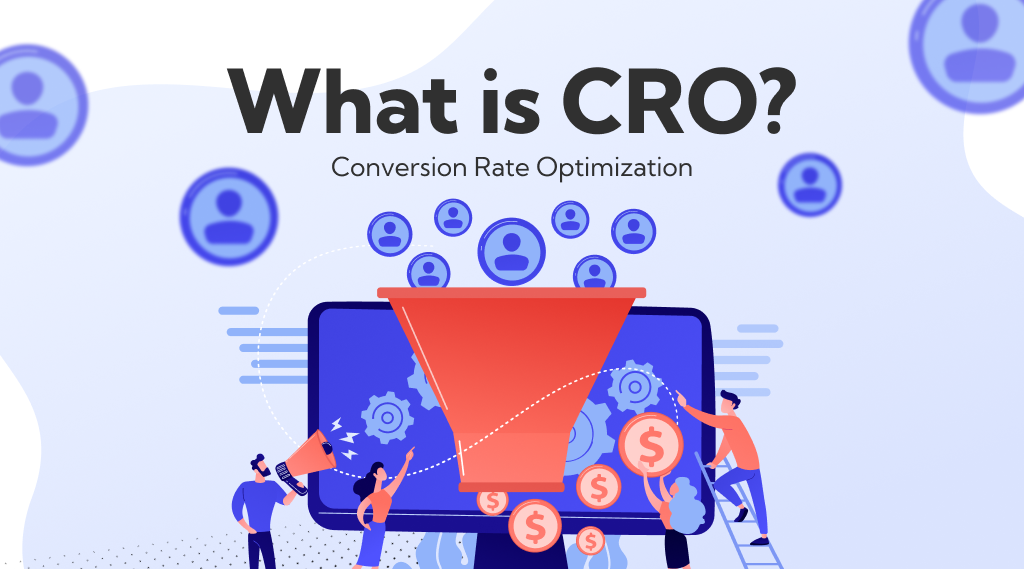Introduction
Conversion Rate Optimization (CRO) is a critical discipline in the realm of digital marketing and business growth. It focuses on enhancing the effectiveness of your online presence to maximize conversions, whether that means increasing leads, sales, or other desired actions. In today’s hypercompetitive landscape, where businesses vie for the attention of increasingly discerning consumers, CRO has become paramount for sustainable success.
This blog delves into the concept of CRO and highlights top strategies to improve demand and lead generation for your organization. It is not enough to merely attract visitors to your website; the key lies in converting these visitors into valuable leads or customers. Effective CRO strategies involve understanding user behavior, refining website design, and employing persuasive techniques to guide visitors toward desired outcomes.
Throughout this exploration, we will uncover tried-and-true methods to optimize your website and marketing campaigns, ultimately boosting conversion rates. From A/B testing and user experience enhancements to persuasive copywriting and data-driven decision-making, these strategies will equip you with the tools needed to transform your digital presence into a lead-generating powerhouse. Utilizing lead magnets and growth marketing tactics can further enhance these efforts, ensuring a steady influx of engaged prospects.
By implementing these CRO strategies, your organization can stay ahead in the competitive digital landscape, delivering tangible results and fueling growth in an ever-evolving marketplace.
What is CRO marketing?
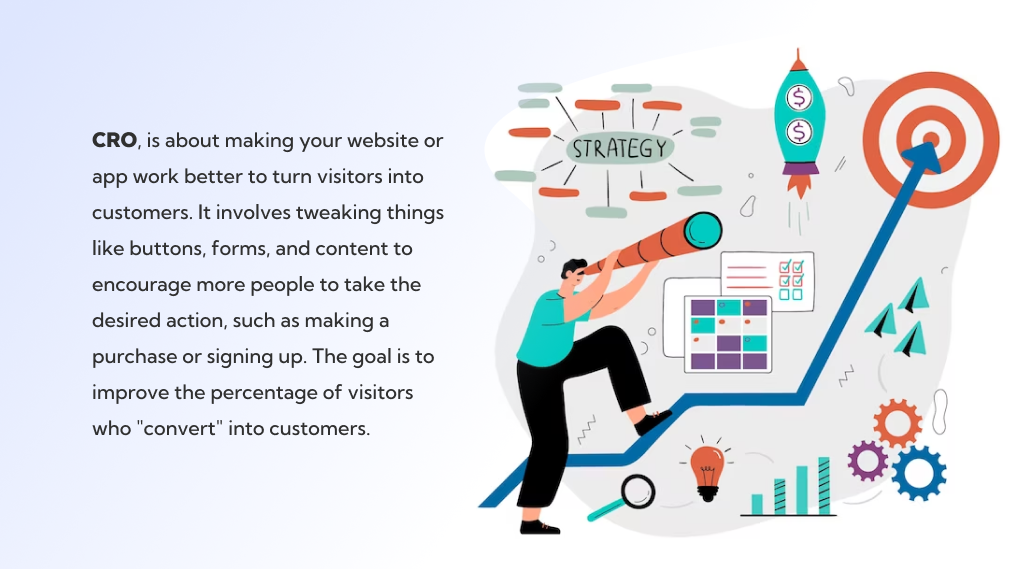
Conversion Rate Optimization (CRO) marketing is a data-driven approach focused on improving the performance of digital marketing efforts and websites. Its primary goal is to increase the percentage of website visitors who take desired actions, such as making a purchase, signing up for a newsletter, or filling out a contact form.
CRO involves analyzing user behavior, conducting A/B testing, and making systematic changes to web elements like design, content, and calls to action to enhance user experience and encourage conversions.
It aims to maximize the return on investment (ROI) for digital marketing campaigns by ensuring that traffic generated through various channels (e.g., SEO, PPC, social media) translates into meaningful outcomes. It involves continuously fine-tuning and optimizing different elements of a website or landing page to remove barriers and objections that might prevent users from taking the desired actions.
By identifying and addressing conversion bottlenecks, it helps businesses increase their revenue, improve customer satisfaction, and make data-backed decisions for ongoing improvements. It’s a vital aspect of modern digital marketing strategies that allows organizations to make the most of their online presence and marketing efforts.
Why is CRO important in marketing?
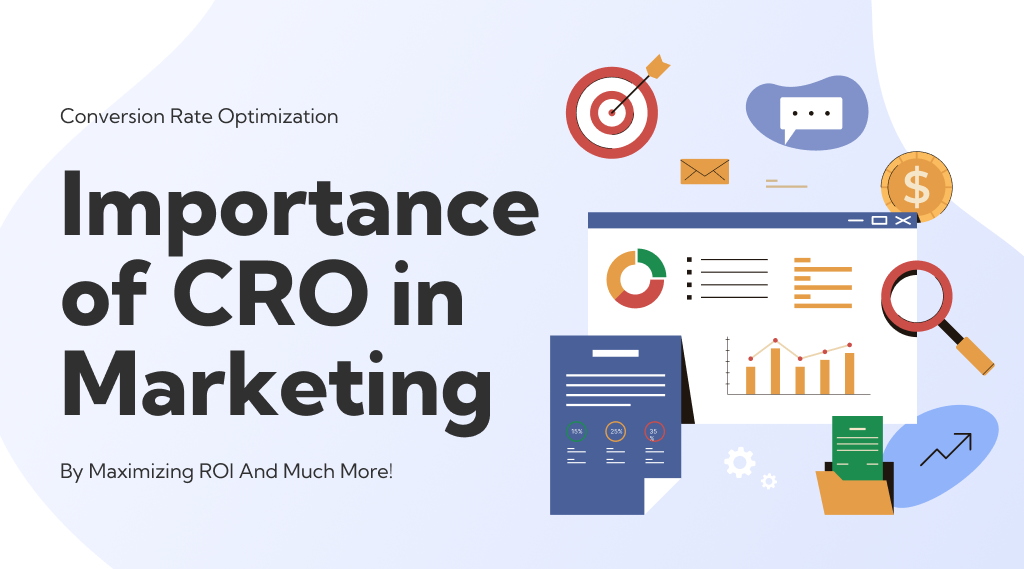
Conversion Rate Optimization (CRO) is crucial in marketing for several compelling reasons:
Maximizing ROI:
CRO ensures that the traffic generated through marketing efforts translates into meaningful actions, such as purchases or lead generation. This optimization maximizes the return on investment, making marketing campaigns more cost-effective.
Data-Driven Decision Making:
CRO relies on data analysis and testing, enabling marketers to make informed decisions. By understanding user behavior and preferences, marketers can tailor strategies for better results.
Enhanced User Experience:
CRO focuses on improving the user experience, resulting in more satisfied visitors. A user-friendly website or marketing campaign is more likely to engage and retain customers.
Competitive Advantage:
In a crowded marketplace, businesses that invest in CRO gain a competitive edge. They adapt to changing consumer behaviors and preferences, staying ahead of rivals.
Better Customer Insights:
CRO often involves gathering valuable customer insights. By understanding why users take specific actions or abandon their carts, businesses can refine their offerings and messaging.
Continuous Improvement:
CRO is an ongoing process that fosters a culture of continuous improvement. It encourages businesses to iterate and evolve their marketing strategies based on real-world performance.
How Do You Calculate the Conversion Rate?
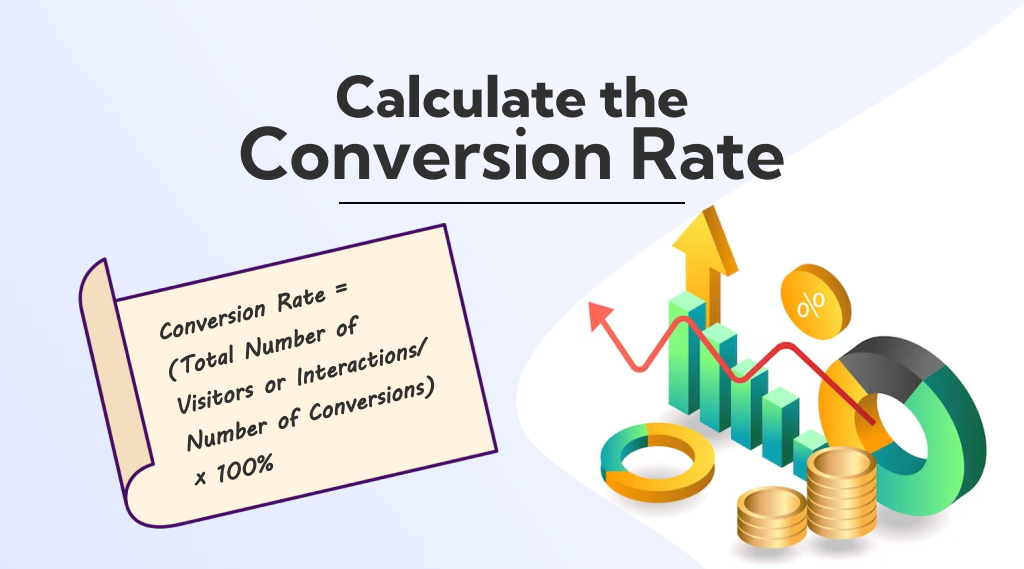
The conversion rate is calculated by dividing the number of conversions by the total number of visitors or interactions and then multiplying the result by 100 to express it as a percentage. The formula for calculating the conversion rate is as follows:
Conversion Rate=(Total Number of Visitors or Interactions/Number of Conversions)×100%
Here’s a breakdown of the elements involved:
Number of Conversions:
This represents the specific action or goal you want users to take on your website or your marketing campaign. Conversions can be purchases, form submissions, sign-ups, downloads, or any other desired action.
Total Number of Visitors or Interactions:
This is the total count of individuals who visited your website or interacted with your marketing materials during a specific time period. It includes both those who converted and those who did not.
Multiply by 100%: To express the conversion rate as a percentage, you multiply the result of the division by 100.
For example, if you had 500 visitors to your website in a month, and 50 of them made a purchase, your conversion rate would be:
Conversion Rate= ( 50/500 )×100%=10%
So, in this case, your conversion rate would be 10%, indicating that 10% of your website visitors converted into customers during that month.
Top Conversion Rate Optimization Strategies to Increase Conversions
Conversion Rate Optimization (CRO) is crucial for any online business aiming to maximize its revenue. By optimizing various elements of your website or sales funnel, you can enhance user experience and ultimately increase conversions. Here are some effective strategies to help you achieve this goal.
1. Conduct Comprehensive A/B Testing:
A/B testing involves comparing two versions of a webpage or element to determine which one performs better in terms of conversions. Test different variations of headlines, call-to-action buttons, layouts, colors, and other elements to identify the most effective combination.
2. Optimize Landing Pages:
Ensure that your landing pages are designed to encourage conversions. Use clear and compelling headlines, concise copy, relevant images or videos, and prominently placed calls-to-action. Simplify the conversion process by minimizing distractions and making forms easy to fill out.
3. Improve Website Speed and Performance:
A slow-loading website can significantly impact your conversion rates. Optimize your site’s speed by minimizing HTTP requests, optimizing images, leveraging browser caching, and using a content delivery network (CDN). A fast and responsive website enhances user experience and encourages visitors to stay longer and convert.
4. Enhance Mobile Responsiveness:
With the increasing use of mobile devices, it’s essential to ensure that your website is fully responsive and mobile-friendly. Test your site across various devices and screen sizes to ensure a seamless user experience. Mobile optimization can significantly improve conversion rates, especially for users browsing on smartphones or tablets.
5. Implement Exit-Intent Pop-ups:
Exit-intent pop-ups are triggered when a user is about to leave your website. These pop-ups can offer special discounts, free resources, or incentives to encourage visitors to reconsider their decision and stay on your site or complete a conversion. Craft compelling offers that provide value to the user and align with their needs and interests.
6. Use Social Proof:
Incorporate social proof elements such as customer testimonials, reviews, case studies, and trust badges to build credibility and trust with your audience. Positive feedback from satisfied customers can help alleviate concerns and objections, making visitors more likely to convert.
7. Personalize User Experience:
Utilize data-driven personalization techniques to deliver tailored content, product recommendations, and offers based on user behavior, preferences, and demographics. Personalized experiences make visitors feel valued and understood, increasing the likelihood of conversion.
8. Optimize Call-to-Action (CTA) Placement and Design:
Your call-to-action buttons should be prominent, visually appealing, and clearly communicate the desired action. Experiment with different CTA placements, sizes, colors, and wording to determine what resonates best with your audience. Use persuasive language that prompts immediate action, such as “Buy Now” or “Get Started.”
9. Simplify Checkout Process:
Streamline the checkout process to reduce friction and eliminate unnecessary steps that may deter users from completing a purchase. Offer guest checkout options, minimize form fields, provide multiple payment methods, and display progress indicators to keep users informed and engaged.
10. Analyze and Iterate:
Continuously monitor key metrics such as conversion rates, bounce rates, and user engagement to identify areas for improvement. Analyze user feedback, conduct usability testing, and gather insights from analytics tools to refine your strategies and optimize conversions over time.
By implementing these conversion rate optimization strategies, you can create a more compelling and user-friendly experience for your audience, ultimately driving higher conversion rates and increasing revenue for your business. Remember to test, analyze, and iterate continuously to stay ahead of the competition and maximize your conversion potential.
How To Create A Perfect Cro Marketing Strategy To Attract Website Visitors
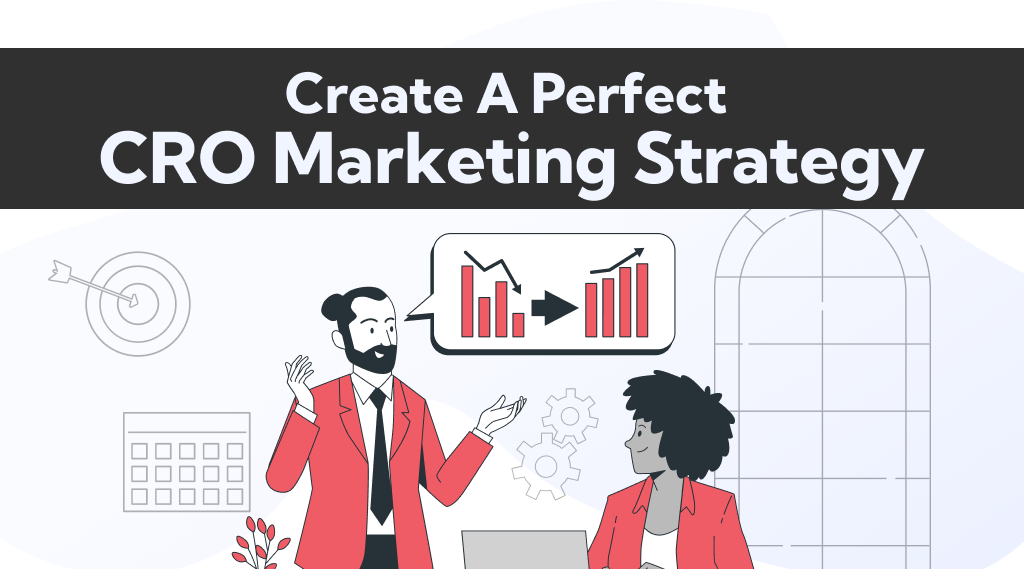
Crafting a perfect Conversion Rate Optimization (CRO) marketing strategy involves a holistic approach that integrates insights from your target audience, conversion data, customer journey, and existing website traffic. By understanding these components and leveraging optimization efforts effectively, you can attract more visitors to your website, boost conversions, and ultimately turn them into paying customers. Here’s how to create an optimal CRO strategy:
1. Define Your Target Audience: Begin by clearly defining your target audience demographics, preferences, and behaviors. Utilize market research, surveys, and customer feedback to gather insights. Tailor your messaging and offers to resonate with your audience effectively throughout their customer journey.
2. Analyze Conversion Data: Analyze your conversion data to uncover patterns, trends, and areas for improvement. Track metrics such as conversion rate, bounce rate, and micro conversions. Understand which pages or elements perform well and which ones need optimization to inform your strategy effectively.
3. Calculate Conversion Rate: Calculate your website’s conversion rate by dividing the number of conversions by the total number of website visitors and multiplying by 100. Understanding your baseline conversion rate helps set goals and measure the impact of optimization efforts on driving conversions.
4. Audit Existing Website Traffic: Conduct a thorough audit of your existing website traffic to understand traffic sources, channels, and user behavior. Identify high-performing channels and areas for improvement. This information helps allocate resources wisely and prioritize optimization strategies throughout the customer journey.
5. Map the Customer Journey: Map out the customer journey from initial awareness to conversion and beyond. Identify key touchpoints and interactions where optimization efforts can be implemented to enhance the user experience and drive conversions. Tailor content and offers to meet the needs of customers at each stage of their journey.
6. Implement Optimization Efforts: Implement optimization efforts across your website based on insights from your target audience, conversion data, and customer journey mapping. Optimize website design, content, calls-to-action, and user experience to encourage micro conversions and ultimately boost overall conversions.
7. Test and Iterate: Conduct A/B tests and multivariate tests to experiment with different variations and identify what resonates best with your audience. Continuously monitor performance data and iterate on your strategies to refine and improve results over time.
8. Convert Micro Conversions into Paying Customers: Focus on converting micro conversions, such as email sign-ups or product page views, into paying customers. Nurture leads through targeted email campaigns, personalized recommendations, and retargeting efforts to encourage them to complete their purchase and become paying customers.
By crafting a comprehensive CRO marketing strategy that considers your target audience, conversion data, customer journey, and optimization efforts, you can attract more website visitors, boost conversions, and turn them into paying customers. Remember to continuously test, iterate, and refine your strategies to maximize results and drive sustainable growth.
What are the CRO marketing metrics to measure
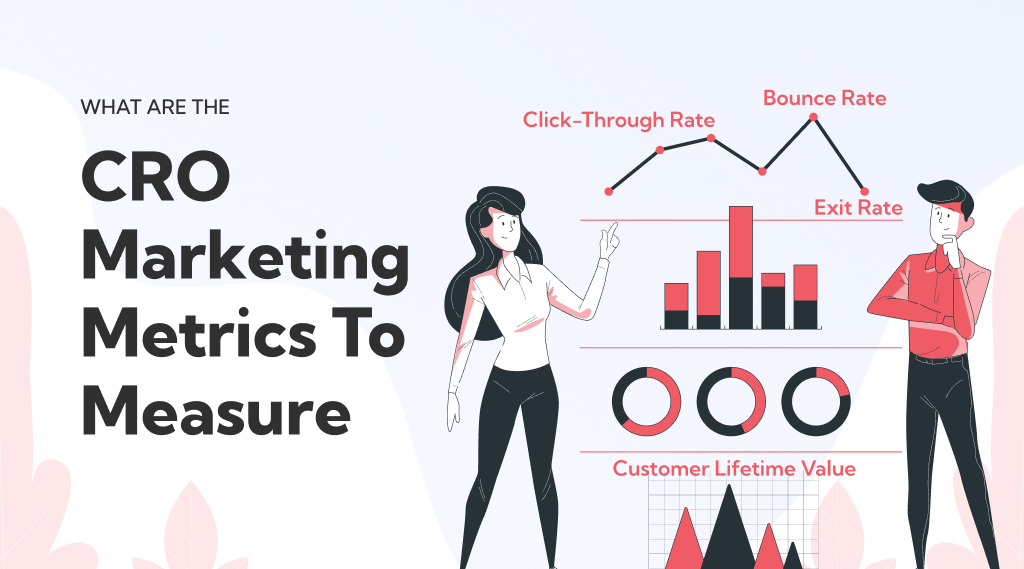
Conversion Rate Optimization (CRO) relies on several key metrics to gauge the effectiveness of your strategies and identify areas for improvement. Here are some essential CRO marketing metrics to measure:
Conversion Rate:
This is the primary metric, representing the percentage of visitors who take a desired action, such as making a purchase, signing up, or downloading content. It’s calculated by dividing conversions by total visitors and multiplying by 100.
Bounce Rate:
Bounce rate measures the percentage of visitors who leave your website after viewing only one page. A high bounce rate can indicate a lack of engagement or relevance.
Click-Through Rate (CTR):
CTR assesses the effectiveness of your calls to action (CTAs) or ad campaigns. It’s the percentage of people who click on a specific link or button.
Average Session Duration:
This metric measures the average time visitors spend on your site. Longer durations often indicate engagement and interest.
Exit Rate:
Exit rate identifies the percentage of visitors who leave your site from a specific page. It helps pinpoint where users are most likely to drop off.
Cart Abandonment Rate:
For e-commerce sites, this metric calculates the percentage of users who add items to their cart but do not complete the purchase. Reducing this rate can significantly impact revenue.
Form Submission Rate:
If your goal is to collect leads through forms, this metric measures the percentage of visitors who complete the form.
Revenue per Visitor (RPV):
RPV quantifies the average revenue generated by each visitor. It’s an important metric for e-commerce and online businesses.
Customer Lifetime Value (CLV):
CLV calculates the total revenue a customer is expected to generate throughout their relationship with your business. It helps you assess the long-term value of conversions.
Conversion Funnel Drop-off Rates:
Analyze drop-off rates at different stages of the conversion funnel to identify where users abandon the process.
Segmented Conversion Rates:
Break down conversion rates by traffic source, device type, location, or other relevant segments to uncover insights about different user groups.
Page Load Time:
Slow-loading pages can deter users from converting. Monitor and optimize page load times for better user experience.
Mobile Conversion Rate:
With increasing mobile users, track the conversion rate specifically for mobile devices to ensure your site is mobile-friendly.
Error Rate:
Monitor and minimize the occurrence of error messages and technical issues that can disrupt the conversion process.
Customer Satisfaction and Net Promoter Score (NPS):
Surveys and feedback mechanisms can help gauge user satisfaction and likelihood to recommend your business, which indirectly impacts conversions.
Cro Marketing Tools:
Conversion Rate Optimization (CRO) relies on various tools and software to analyze, optimize, and improve website and marketing performance. Here are some essential CRO marketing tools:
Google Analytics:
Provides comprehensive website analytics, including user behavior, traffic sources, and conversion tracking.
Google Optimize: A/B testing and personalization platform integrated with Google Analytics to test different variations of web pages and analyze their impact on conversions.
Optimizely: A popular A/B testing and experimentation platform that allows you to test and optimize various elements on your website.
Hotjar: Offers heatmaps, session recordings, and surveys to understand how users interact with your site and identify areas for improvement.
Crazy Egg: Provides heatmaps, scroll maps, and user session recordings to visualize user behavior and optimize web pages.
VWO (Visual Website Optimizer): A comprehensive A/B testing and multivariate testing platform with personalization features.
Unbounce: A landing page builder and optimization platform that simplifies the creation of high-converting landing pages.
Convert.com: A CRO platform offering A/B testing, multivariate testing, split URL testing, and personalization features.
Mouseflow: Provides session replays, heatmaps, and funnel analysis to understand user journeys and improve website usability.
Lucky Orange: Offers session recordings, live chat, heatmaps, and conversion funnels to optimize website performance.
What is CRO vs. SEO?
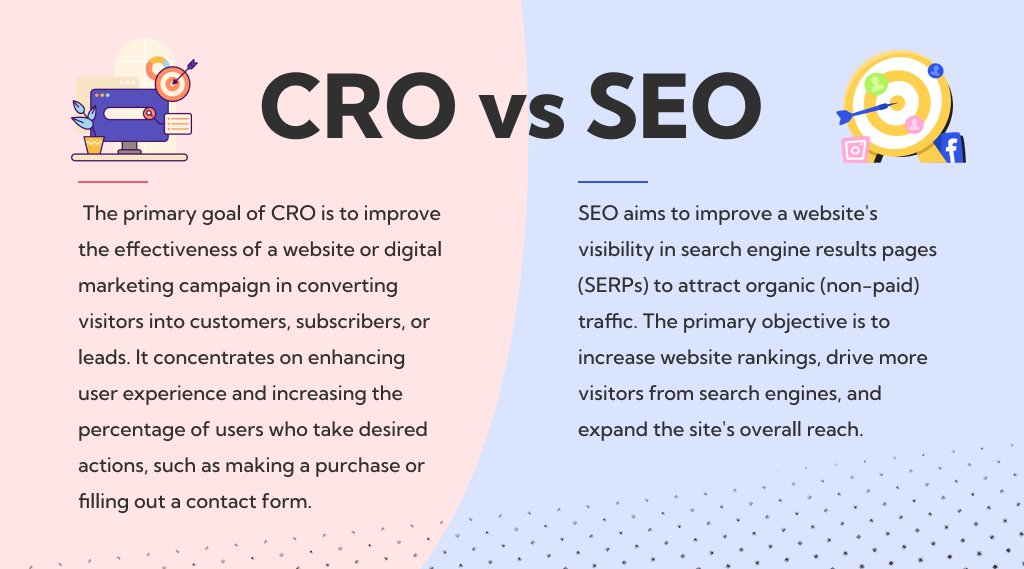
CRO (Conversion Rate Optimization) and SEO (Search Engine Optimization) are both crucial aspects of digital marketing, but they focus on different objectives and strategies:
Objective:
CRO (Conversion Rate Optimization): The primary goal of CRO is to improve the effectiveness of a website or digital marketing campaign in converting visitors into customers, subscribers, or leads. It concentrates on enhancing user experience and increasing the percentage of users who take desired actions, such as making a purchase or filling out a contact form.
SEO (Search Engine Optimization): SEO aims to improve a website’s visibility in search engine results pages (SERPs) to attract organic (non-paid) traffic. The primary objective is to increase website rankings, drive more visitors from search engines, and expand the site’s overall reach.
Focus:
CRO: CRO focuses on optimizing elements within a website or marketing funnel, such as landing pages, forms, calls to action, and user experience. It aims to make the most of the existing traffic by improving the conversion process.
SEO: SEO concentrates on enhancing a website’s content, structure, and technical aspects to make it more search engine-friendly. It involves keyword research, on-page optimization, backlink building, and improving site speed, among other factors.
Metrics:
CRO: Metrics for CRO include conversion rate, bounce rate, click-through rate (CTR), cart abandonment rate, and revenue per visitor. These metrics assess how well a website converts its visitors into customers or leads.
SEO: SEO metrics include organic search traffic, keyword rankings, click-through rate in search results, backlink quality, and domain authority. These metrics measure a website’s performance in search engines.
Timeframe:
CRO: CRO changes can yield relatively quick results, often within weeks or months, as optimizations directly impact the conversion process.
SEO: SEO is a longer-term strategy, with results typically taking several months to become noticeable. Achieving high rankings and organic traffic growth is an ongoing effort.
Overlap:
While CRO and SEO have distinct focuses, they can complement each other. A website with good SEO that attracts more organic traffic can benefit from CRO to convert those visitors effectively.
Conclusion
Conversion Rate Optimization (CRO) is a vital practice in the digital marketing landscape that holds the power to transform website traffic into tangible business outcomes. It is the art and science of fine-tuning websites and marketing campaigns to maximize conversions, whether they are sales, leads, or other desired actions.
CRO empowers businesses to make the most of their existing audience by enhancing the user experience, optimizing content, and continuously testing and refining strategies.
In a world where competition for online attention is fierce, CRO has become an essential strategy for businesses aiming to thrive in the digital realm. By leveraging data-driven insights and employing tools and techniques that enhance user engagement and satisfaction, organizations can not only boost conversion rates but also improve customer loyalty and overall profitability.
The CRO journey is an ongoing process, demanding continuous monitoring, testing, and adaptation. It involves understanding the unique needs and behaviors of your audience, tailoring content and design to match those needs, and staying attuned to the ever-evolving digital landscape. Ultimately, CRO is a dynamic and iterative approach that empowers businesses to harness the full potential of their digital presence and turn it into measurable success.
Ready to supercharge your SaaS marketing efforts and unlock the full potential of your software product? Look no further than Revvgrowth!
FAQs
What is Conversion Rate Optimization (CRO), and why is it important for lead generation?
Conversion Rate Optimization (CRO) is the process of improving a website or landing page to increase the percentage of visitors who take a desired action, such as filling out a lead generation form, making it important for lead generation because it enhances the efficiency and effectiveness of converting website visitors into leads.
What are some common barriers to conversion, and how can CRO strategies address them?
Common barriers to conversion include unclear messaging, slow website speed, complicated forms, and lack of trust; CRO strategies can address these by refining messaging, optimizing website performance, simplifying forms, and building trust through testimonials and trust badges.
Can you provide examples of effective CRO strategies for demand generation?
Effective CRO strategies for demand generation include A/B testing ad copy and landing page variations, creating compelling CTAs, implementing exit-intent pop-ups, personalizing content, and simplifying the conversion process.
How does A/B testing fit into a CRO strategy, and what are some best practices for conducting A/B tests?
A/B testing is a crucial component of CRO, as it involves comparing two or more variations of a webpage or element to determine which one performs better in terms of conversion rates; best practices include defining clear objectives, testing one element at a time, ensuring a large enough sample size, and analyzing results statistically for valid conclusions.
What role does content play in CRO for lead generation, and how can content be optimized to improve conversions?
Content in CRO for lead generation plays a pivotal role in attracting, engaging, and persuading visitors; it can be optimized by creating targeted and valuable content, using persuasive language, employing clear CTAs, and leveraging customer testimonials and case studies to build trust and credibility.

